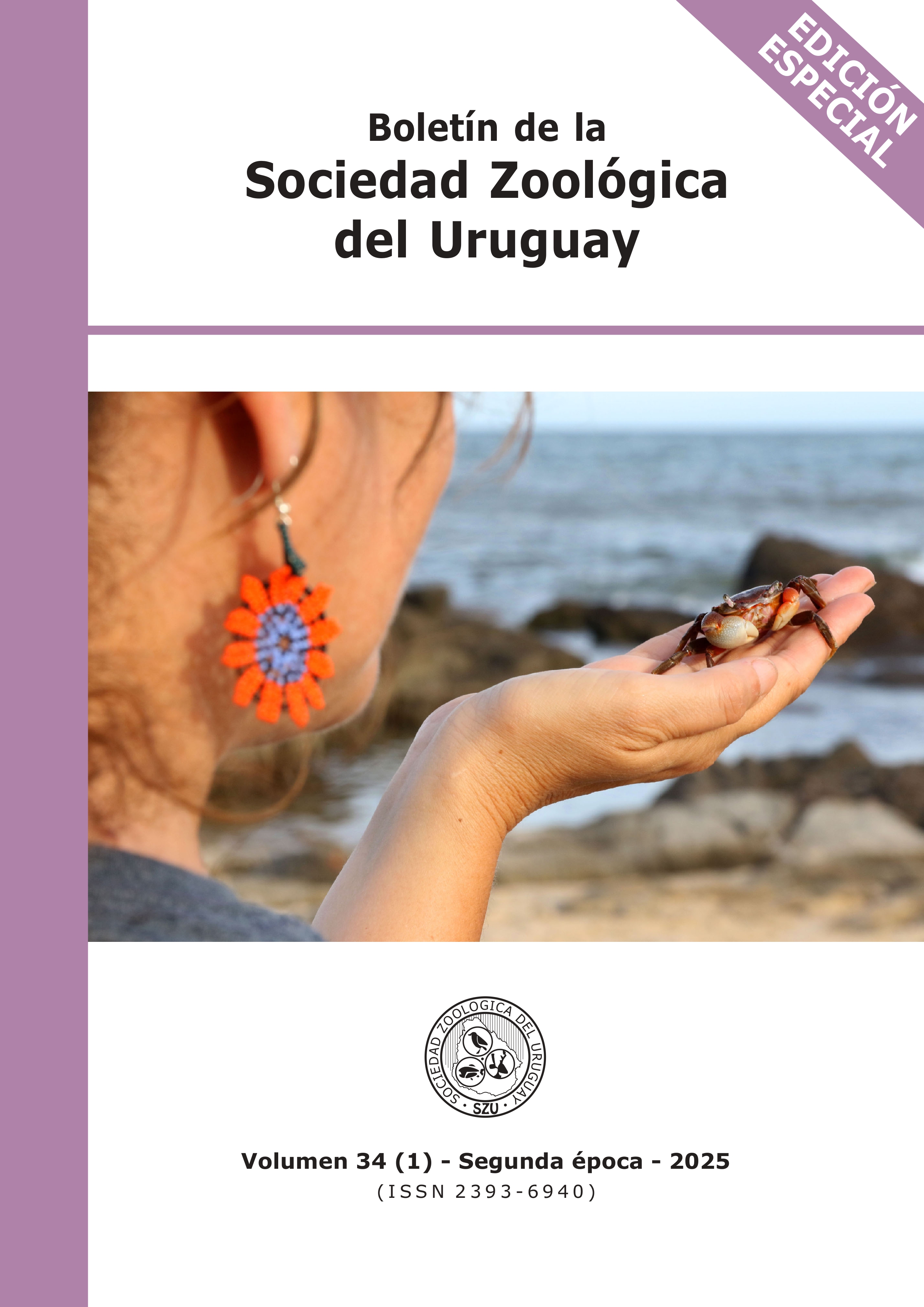REPRODUCTIVE BIOLOGY OF Melanophryniscus devincenzii (ANURA: BUFONIDAE) IN SOUTHERN BRAZIL
DOI:
https://doi.org/10.26462/34.1.8Keywords:
Explosive reproduction, reproductive investment , fecundity, fat bodiesAbstract
The reproductive biology of Melanophryniscus devincenzii was described here, based on morphometrics and gonadal analysis of 86 individuals collected in the Sertão Municipal Natural Park, Rio Grande do Sul, Brazil. Individuals were captured both manually and using pitfall traps. We identified 63 males and 23 females, with the sex ratio biased towards males. Sexual dimorphism was observed, with females being larger than males. No significant correlation was found between female body size and oocyte number, nor between male body size and testicular mass, indicating that energetic investment may be more focused on reproduction than on growth. All analyzed females (except one) exhibited mature oocytes, immature and atretic oocytes in their ovaries, suggesting that females may be latent to reproductive event. This reproductive latency benefit to those species that have explosive reproductive events and depend on rainfall.
Downloads
References
Airaldi, K., Baldo, J.D., & Lavilla, E.O. (2009). Amphibia, Anura, Bufonidae, Melanophryniscus devincenzii: First record for Paraguay and geographic distribution map.
Bastos, R.P.; Martins, M.R.; Guidorizzi, C.E.; Andrade, S.P.; Bataus, Y.S.L.; Faria, D.C.C.; … Zank, C. (2023). Melanophryniscus devincenzii. Sistema de Avaliação do Risco de Extinção da Biodiversidade - SALVE. Disponível em: https://salve.icmbio.gov.br Digital Object Identifier (DOI): https://doi.org/10.37002/salve.ficha.17803.2 - Acesso em: 11 de set. de 2024.
Bortolini, S.V., Maneyro, R., Coppes, F.A., & Zanella, N. (2013). Diet of Melanophryniscus devincenzii (Anura: Bufonidae) from Parque Municipal de Sertão, Rio Grande do Sul, Brazil. The Herpetological Journal, 23(2), 115-119.
Bortolini, S.V., Gonçalves, F.A., & Zanella, N. (2018). Reproductive aspects of a population of Physalaemus gracilis (BOULENGER 1883) (Anura: Leptodactylidae) from south Brazil. Neotropical Biology and Conservation, 13(1), 37.
Brusquetti, F., & Lavilla, E.O. (2006). Lista comentada de los anfibios de Paraguay. Cuadernos de herpetología, 20.
Bustos Singer, R., & Gutiérrez, M. (1997). Reproducción y desarrollo larval del sapo enano Melanophryniscus stelzneri stelzneri (Weyemberg, 1875) (Anura: Bufonidae). Cuadernos de Herpetología, 11.
Cairo, S.L., Zalba, S.M., & Úbeda, C.A. (2008). Reproductive behaviour of Melanophryniscus sp. from Sierra de la Ventana (Buenos Aires, Argentina). South American Journal of Herpetology, 3(1), 10-14.
Cairo, S.L., Zalba, S.M., & Úbeda, C.A. (2013). Reproductive pattern in the southernmost populations of South American redbelly toads. Journal of Natural History, 47(31-32), 2125-2134.
Camargo, A., Naya, D.E., Canavero, A., da Rosa, I., Maneyro, R., & Naya, D.A. (2005). Seasonal activity and the body size-fecundity relationship in a population of Physalaemus gracilis (Boulenger, 1883) (Anura, Leptodactylidae) from Uruguay. In Annales Zoologici Fennici (pp. 513-521). Finnish Zoological and Botanical Publishing Board.
Camargo, A., Sarroca, M., & Maneyro, R. (2008). Reproductive effort and the egg number vs. size trade-off in Physalaemus frogs (Anura: Leiuperidae). Acta oecologica, 34(2), 163-171.
Caorsi VZ. (2011). Comportamento reprodutivo de Melanophryniscus cambaraensis (Anura: Bufonidae) na Floresta Nacional de São Francisco de Paula, Rio Grande do Sul, Brasil [undergraduate thesis]. [Porto Alegre (RS)]: Universidade Federal de Rio Grande do Sul.
Caramaschi, U., & Cruz, C.A.G. (2002). Taxonomic status of Atelopus pachyrhynus Miranda-Ribeiro,1920,redescription of Melanophryniscus tumifrons (Boulenger, 1905), and descriptions of two new species of Melanophryniscus from the state of Santa Catarina, Brazil (Amphibia, Anura, Bufonidae).
Arquivos do Museu Nacional, 60(4), 303-314.
Cardoso, A.J., & Martins, J.E. (1985). Diversidade de anuros durante o turno de vocalizações, em comunidade neotropical. Papéis avulsos de Zoologia, 36, 279-285.
Carrillo, J.F., Rocha, P.C., Cabral, A.A.F., Firme, M.S.F., Serafim, L.L., Mori, K.Y., & Santana, D.J.
(2024). Diet, sexual dimorphism, and fertility aspects of Melanophryniscus fulvoguttatus (Mertens, 1937) from Central-East Brazil. Herpetozoa, 37, 141-147.
Cechin, S.Z., & Martins, M. (2000). Eficiência de armadilhas de queda (pitfall traps) em amostragens de anfíbios e répteis no Brasil. Revista brasileira de zoologia, 17, 729-740.
de Oliveira, E.F., Feio, R.N., & da Matta, S.L.P. (2007). Aspectos reprodutivos de Dendropsophus minutus (Peters, 1872) no município de Viçosa, Minas Gerais. Revista Ceres, 54(313), 231-239.
Díaz-Páez, H., & Ortiz, J.C. (2001). The reproductive cycle of Pleurodema thaul (Anura, Leptodactylidae) in central Chile. Amphibia-Reptilia, 22(4), 431-445.
Duellman, W.E., & Trueb, L. (1986). Biology of amphibians. Baltimore, the John Hopkins University Press.
Duré, M.I., Schaefer, E.F., & Kehr, A.I. (2015). Acoustic repertoire of Melanophryniscus cupreuscapularis (Céspedez and Álvarez 2000) (Anura: Bufonidae): advertisement, encounter, and release calls. Journal of Herpetology, 49(1), 53-59.
Fernández, K. (1927). Reproducción de batracios argentinos (segunda parte). Boletin Acad. Nac. de Ciencias en Cordoba, 29, 271-328.
Frost, J.S. (1983). Comparative feeding and breeding strategies of a sympatric pair of leopard frogs (Rana pipiens complex). Journal of Experimental Zoology, 225(1), 135-140.
Frost, D.R. (2024). Amphibian Species of the World: an Online Reference. Version 6.2 (Date of access). Electronic Database accessible at https://amphibiansoftheworld.amnh.org/index.php. American Museum of Natural History, New York, USA. doi.org/10.5531/db.vz.0001.
Goldberg, F.J., Quinzio, S., & Vaira, M. (2006). Oviposition-site selection by the toad Melanophryniscus rubriventris in an unpredictable environment in Argentina. Canadian Journal of Zoology, 84(5), 699-705.
Grafe, T.U., Schmuck, R., & Linsenmair, K.E. (1992). Reproductive energetics of the African reed frogs, Hyperolius viridiflavus and Hyperolius marmoratus. Physiological Zoology, 65(1), 153-171.
Haddad, C.F., & Prado, C.P. (2005). Reproductive modes in frogs and their unexpected diversity in the Atlantic Forest of Brazil. BioScience, 55(3), 207-217.
Hammer, Ø., Harper, D.A., & Ryan, P.D. (2001). PAST: Paleontological statistics software package for education and data analysis. Palaeontologia electronica, 4(1), 9.
Hillman, S.S., Withers, P.C., Drewes, R.C., & Hillyard, S.D. (2009). Ecological and environmental physiology of amphibians. Oxford University Press.
IUCN SSC Amphibian Specialist Group. (2023). Melanophryniscus devincenzii. The IUCN Red List of Threatened Species 2023: e.T54819A101423809. https://dx.doi.org/10.2305/IUCN.UK.2023-1.RLTS.T54819A101423809.en. Accessed on 08 October 2024.
Jørgensen, C. (1992). Growth and reproduction. Environmental physiology of the amphibians.
Lajmanovich, R.C. (2000). Interpretación ecológica de una comunidad larvaria de anfibios anuros. Interciencia, 25(2), 71-79.
Langone, J.A., & Lavilla, E.O. (2024). Una revisión histórica de los nombres aplicados a las especies del género Melanophryniscus Gallerdo, 1961 (Amphibia: Anura: BUfonidae). Comunicaciones Zoológicas del Museo Nacional de Historia Natural. 13(209), 1-139.
Maneyro, R., & Carreira, S. (2016). Guía de anfibios del Uruguay. Segunda Edición. Ediciones de la Fuga.
Méndez-Tepepa, M., Morales-Cruz, C., García-Nieto, E., & Anaya-Hernández, A. (2023). A review of the reproductive system in anuran amphibians. Zoological Letters, 9(1), 3.
Pereira, G., & Maneyro, R. (2012). Size-fecundity relationships and reproductive investment in females of Physalaemus riograndensis Milstead, 1960 (Anura, Leiuperidae) in Uruguay. The Herpetological Journal, 22(3), 145-150.
Pereira, G., Abadie, M., & Maneyro, R. (2015). Reproductive pattern and dynamics of fat bodies in males of a Uruguayan population of Physalae musriograndensis (Anura, Leptodactylidae). Studies on Neotropical Fauna and Environment, 50(3), 213-220.
Pereyra, L., Lescano, J., & Leynaud, G. (2011). Breeding-site selection by red-belly toads, Melanophryniscus stelzneri (Anura: Bufonidae), in Sierras of Córdoba, Argentina. Amphibia-Reptilia, 32(1), 105-112.
Pereyra, L.C., Akmentins, M.S., Sanabria, E.A., & Vaira, M. (2016). Diurnal? Calling activity patterns reveal nocturnal habits in the aposematic toad Melanophryniscus rubriventris. Canadian Journal of Zoology, 94(7), 497-503.
Prado, C.P.A., Uetanabaro, M., & Lopes, F.S. (2000). Reproductive strategies of Leptodactylus chaquensis and L. podicipinus in the Pantanal, Brazil. Journal of Herpetology, 135-139.
Prigioni, C.M., & Garrido, R.R. (1989). Algunas observaciones sobre la reproducción de Melanophryniscus stelzneri montevidensis (Anura, Bufonidae). Boletín de la Sociedad Zoológica del Uruguay, 5, 13-14.
Saidapur, S.K., & Hoque, B. (1996). Long-term effects of ovariectomy on abdominal fat body and body masses in the frog Rana tigrina during the recrudescent phase. Journal of Herpetology, 30(1), 70-73.
Shine, R. (1979). Sexual selection and sexual dimorphism in the Amphibia. Copeia, 297-306.
Vaira, M. (2005). Annual variation of breeding patterns of the toad, Melanophryniscus rubriventris (Vellard, 1947). Amphibia-Reptilia, 26(2), 193-199.
Wells, K.D. (1977). The social behaviour of anuran amphibians. Animal Behaviour, 25, 666-693.
Wells K.D. (2019). The ecology and behavior of amphibians. University of Chicago Press.
Zar, J.H. (2010). Biostatistical Analysis, Fifth Edition, Prentice Hall.











